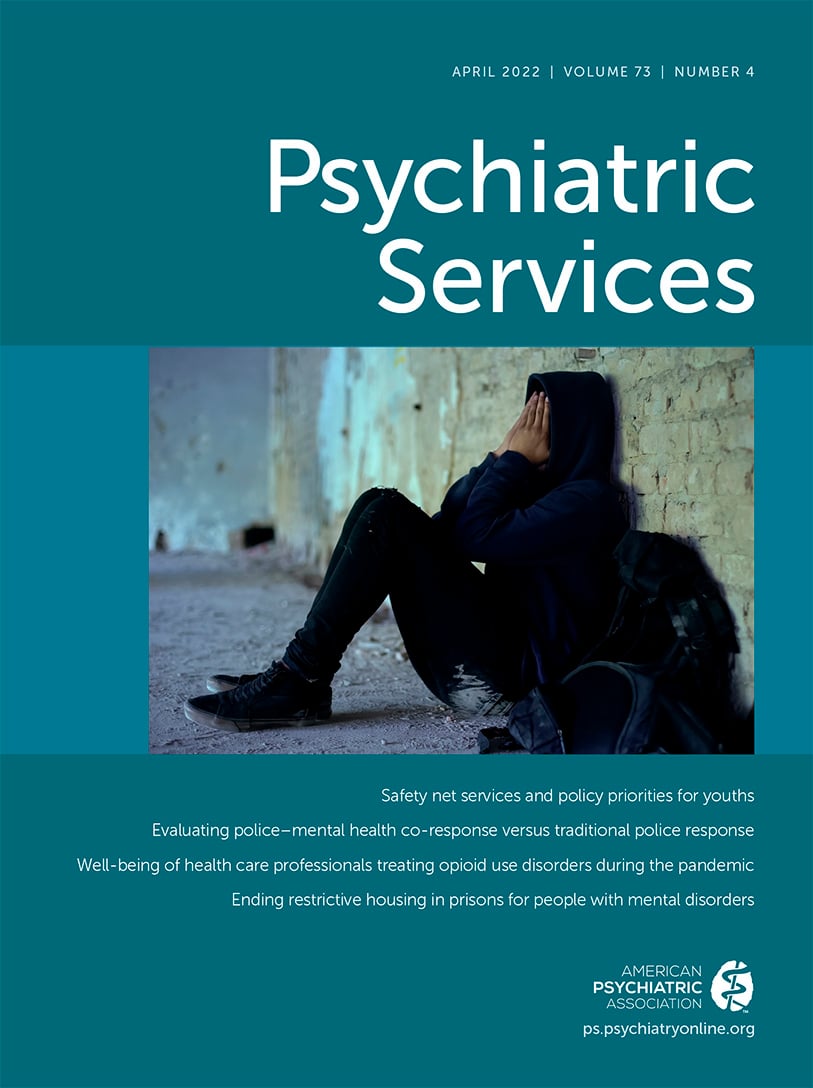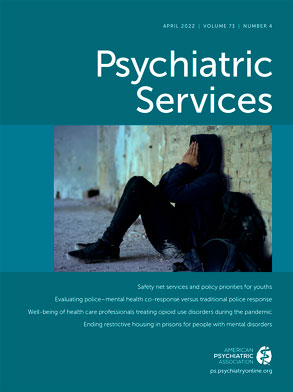Intentional medication overdose is the most frequently used method in attempted suicide in the United States and the third most common means of completed suicide (
1). Clinicians can play an important, but often overlooked, role in protecting suicidal patients by limiting access to large quantities of high-risk medications. However, in recent years this suicide prevention strategy has faced challenges in the United States because of the ascent of the 90-day prescription.
Ninety-day prescriptions are legal in all U.S. states, and most medications can be legally dispensed in this manner. As of 2015, a total of 27 states had no restrictions forbidding 90-day prescriptions for any controlled substance (
2). Because of reduced costs associated with bulk medication dispensing, insurers, pharmacies, and pharmacy benefit managers are financially incentivizing patients to obtain 90-day prescriptions (
3). The rise of quality metrics measuring medication adherences, usually assessed indirectly from pharmacy claims (
4), has further fueled insurers’ efforts to increase the market share of 90-day prescriptions. For example, the Centers for Medicare and Medicaid Services has incorporated medication adherence for some chronic conditions as a heavily weighted factor in its Star Ratings Program, which determines whether Medicare prescription drug plans qualify for quality-based bonus payments (
5). Faced with medication adherence quality metrics of their own and the possibility of prior authorization requirements when prescribing maintenance medication supplies in quantities smaller than for 90-days (
6,
7), prescribers are also pivoting toward 90-day prescriptions.
From 2010 to 2020, the share of prescriptions that were filled at retail pharmacies for a 90-day supply increased from 7% to 23%, and in 2020, 74% of mail-order pharmacy–dispensed prescriptions were 90-day prescriptions (
8). This shift from 30-day prescriptions has had mixed consequences. On one hand, patients tend to favor 90-day prescriptions because of fewer and cheaper copays. They also require fewer pharmacy visits and are often eligible for home delivery, which is appealing amid the COVID-19 pandemic. Ninety-day prescriptions may also improve patient health through increased medication adherence (
9). However, they raise challenges during periods of dosage adjustment, and there is concern that they could weaken treatment alliances by reducing the frequency of clinic visits.
Most worrisome, however, is the 90-day prescription’s danger to patients at risk for suicide, because the number of tablets contained in a medication’s packaging is positively associated with medication quantities consumed in overdose attempts (
10). Although many commonly used medications have favorable therapeutic indexes, they still can be fatal when taken in large quantities. For example, in a 2020 study (
11) of 421,466 intentional drug overdoses, antidepressants were involved in 16%−17% of fatalities, and of those fatalities, 64% were attributable to antidepressants. Numerous fatalities in that study also resulted from nonpsychiatric medications like antidiabetics, antiemetics, and antihypertensives.
Prior authorization requirements by insurers can significantly affect psychiatrists’ decision making (
12), particularly when they see many patients and face clinical time pressures. As a result, requiring prior authorization for coverage of medication supplies shorter than 90 days (
6,
7) may incentivize prescribers to write 90-day prescriptions, even if this would not be their preference. This potential effect is especially worrisome when patients are being discharged after psychiatric hospitalizations, where inpatient clinicians have traditionally prescribed conservative quantities because of the high-risk period for suicide that follows discharge. The possibility of insurers denying prior authorization requests for smaller medication quantities at the time of discharge is a real concern.
Insurers should be more thoughtful of the risks posed to suicidal patients by strongly incentivizing 90-day medication supplies, especially because many insurers have already established their capacity to create prescription coverage policies that induce safer prescribing practices instead of potentially harmful ones. For example, the number of days supplied in an index opioid prescription has been linked to long-term opioid use, and many insurers recently have responded by adjusting their policies so that only short initial opioid prescriptions are covered without prior authorization (
13), even when state laws mandate no such restrictions.
Although we are unaware of studies delineating the role of 90-day prescriptions in intentional overdoses—an avenue of inquiry in need of investigation—it is likely that these prescriptions increase lethal overdose risk. Consuming single doses equal to 30-day supplies of medications like bupropion and lithium at typical maximum dosages can prove fatal for more than half of individuals weighing 60 kg (132 lb); however, one must consume a dose equal to a 60-day or 90-day supply of others, such as fluoxetine, sertraline, and olanzapine, to reach similar levels of potential lethality (
14). Furthermore, mail-order pharmacies dispensing 90-day prescriptions generally allow refills after 60 days, presenting opportunities for accelerated medication stockpiling. In addition to elevating mortality risk, consumption of larger medication quantities in overdoses involving 90-day supplies also increases risk for injury and intensive medical interventions after overdose.
Whereas 90-day prescriptions pose serious dangers for patients at risk for suicide, 30-day prescriptions can lead to undertreatment via forgotten refills and patients’ hesitancy to pay more frequent copays. Consequently, determining prescription duration in a patient population at risk for suicide is difficult and should be left up to treating clinicians. Yet, there has been a recent proliferation of state laws allowing pharmacists to unilaterally convert many 30-day prescriptions with refills (usually noncontrolled substances) to 90-day prescriptions. In some states, pharmacies are not required to notify prescribers of conversions, and in others they can do so after the conversion. This practice is alarming, because pharmacists are not typically trained in suicide risk assessment and usually do not have access to clinical records. Further complicating matters, pharmacists at large retail chains are being pressured by employers to encourage patients to sign up for 90-day prescriptions to meet certain performance metrics (
15).
We propose several potential interventions to mitigate safety challenges posed by 90-day prescriptions without significantly attenuating these prescriptions’ benefits. Foremost among our suggestions is regulation requiring insurers to develop a streamlined digital process that enables prescribers to override 90-day prescription requirements or request that a 90-day supply be dispensed in multiple shipments. Regulations should also require that pharmacists must receive permission from prescribers before dispensing 30-day prescriptions with refills as 90-day supplies.
Second, regulators could maintain a list of high-risk medications for which insurer 90-day prescription coverage requirements are forbidden. Pharmacists could also be prohibited from converting 30-day prescriptions of these medications with refills to 90-day supplies in states where such conversions in general are permitted without prescriber consultation. The Institute for Safe Medication Practices’ list of high-alert medications (
16) could provide a useful framework for this intervention. To reduce the financial burden of 30-day supplies for patients at risk for suicide and to remove the financial incentive of requesting a 90-day supply from their prescriber, regulators could require insurers to charge the same copay for these medications whether they are dispensed as a single 90-day supply or 30-day supply with two refills.
Unfortunately, curating a centralized list of high-risk medications could be labor intensive and require ongoing funding. A potentially more auspicious alternative would be regulation requiring a “dispense as written” feature on prescriptions dedicated to medication quantity or number of days supplied, similar to the one already in place for medication source (i.e., brand name vs. generic). Expanding this feature would eliminate the need for a centralized medication list and instead allow prescribers to individualize dispensing decisions for high-risk medications.
Finally, pharmacist training and continuing education programs should incorporate suicide prevention strategies related to prescription medications. Optimal instruction would include training in how to identify patients at risk for suicide, screen for suicidal ideation, and intervene if concerns arise. Among other public health benefits, this could result in pharmacists reducing 90-day prescription conversions for at-risk patients.
Increasing pressure from insurers, pharmacies, and pharmacy benefit managers to write 90-day prescriptions has eroded prescriber autonomy and complicated care of patients with mental illness. However, through collaboration between key stakeholders and the mental health care community, as well as implementation of targeted regulation, our society can minimize the 90-day prescription’s potential for harm while still continuing to reap its benefits.

